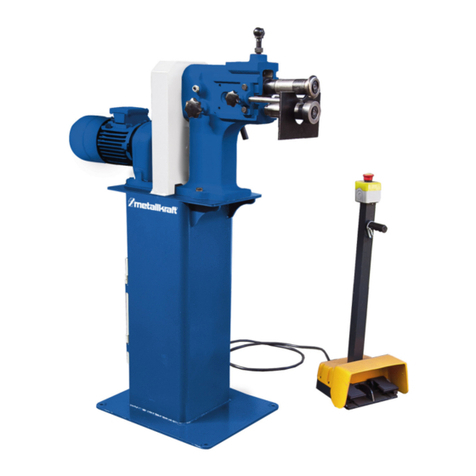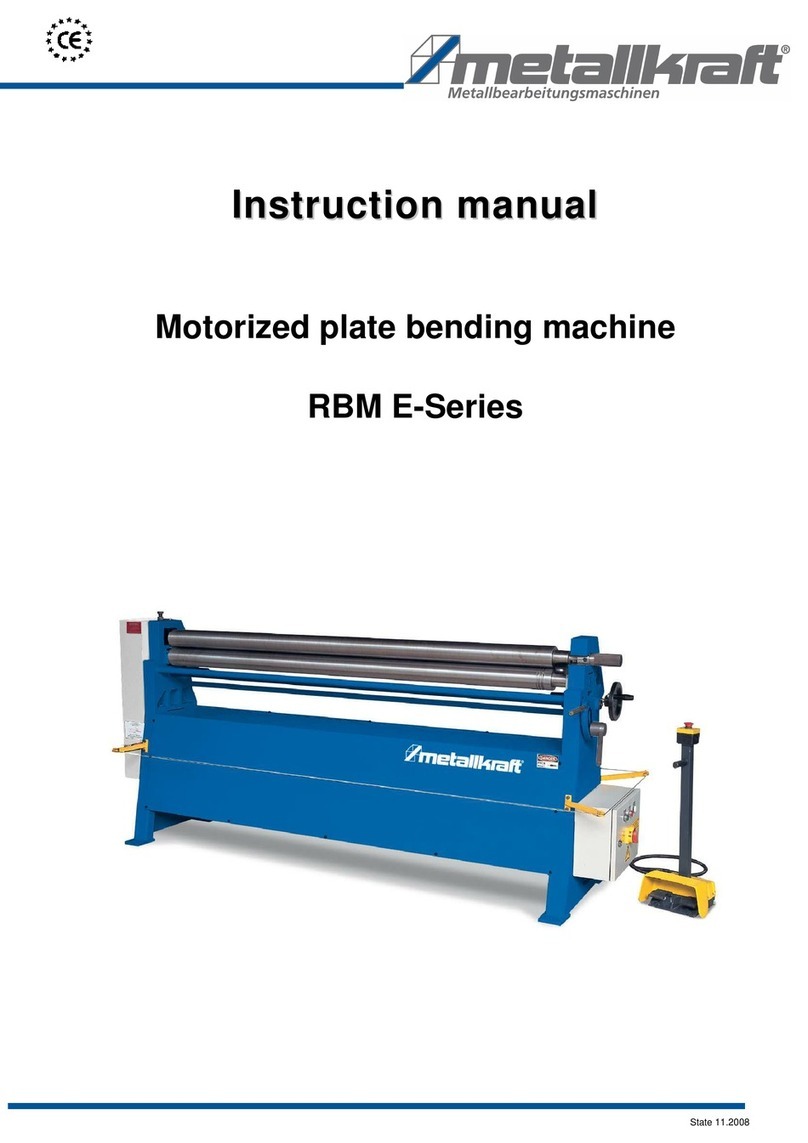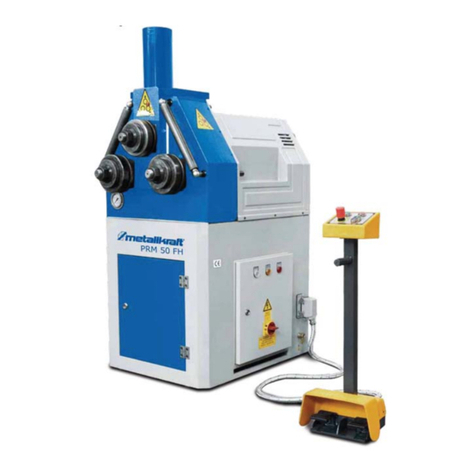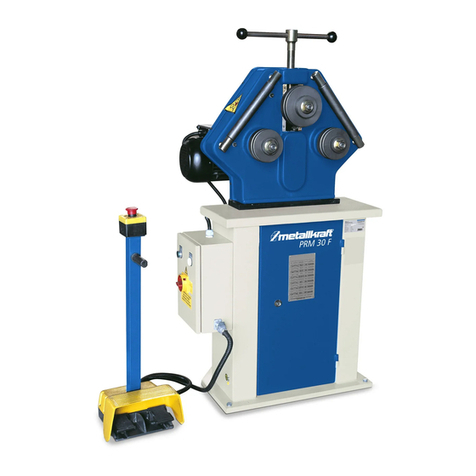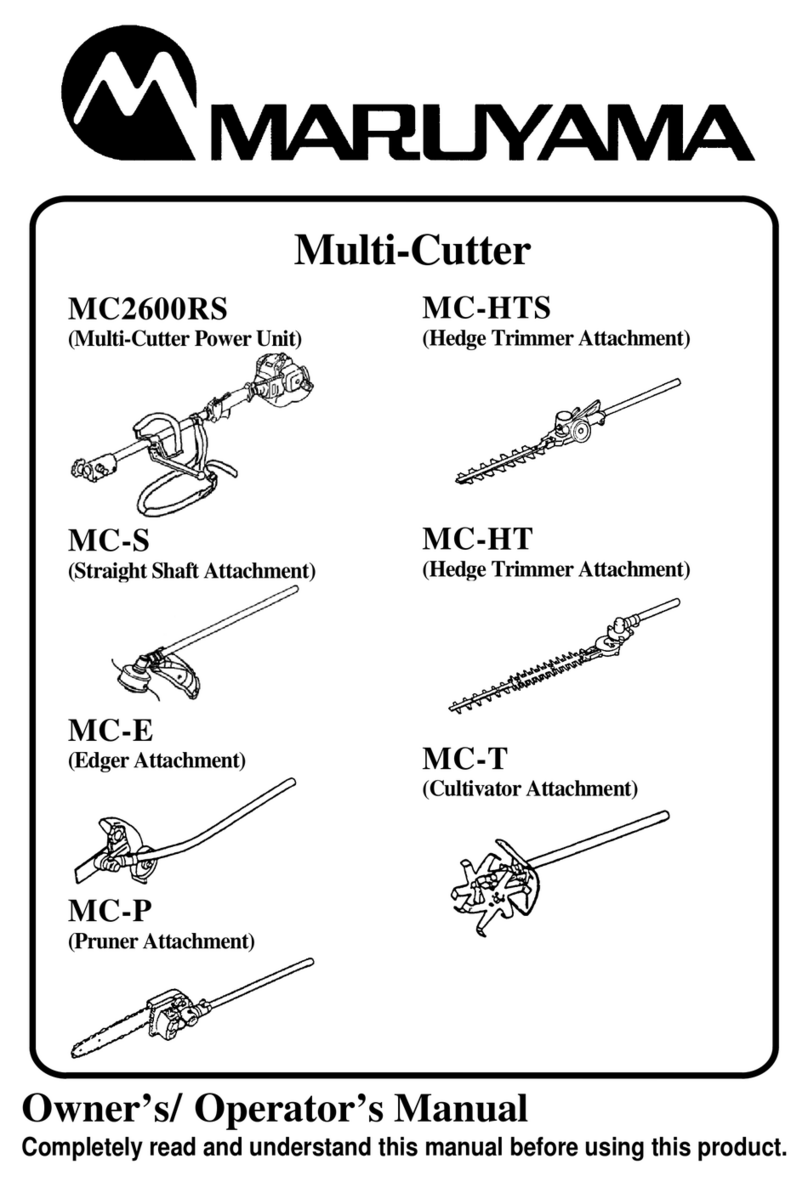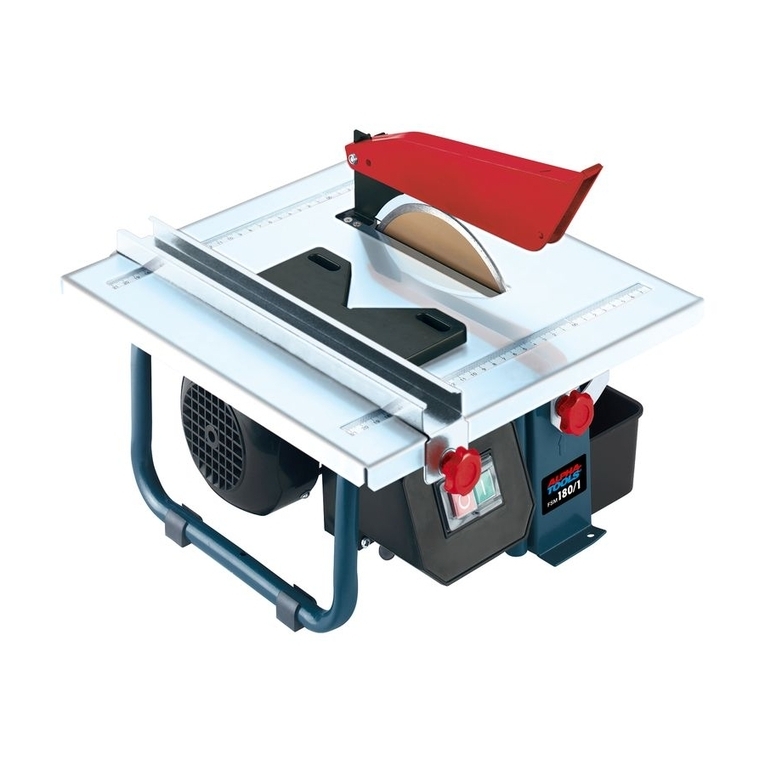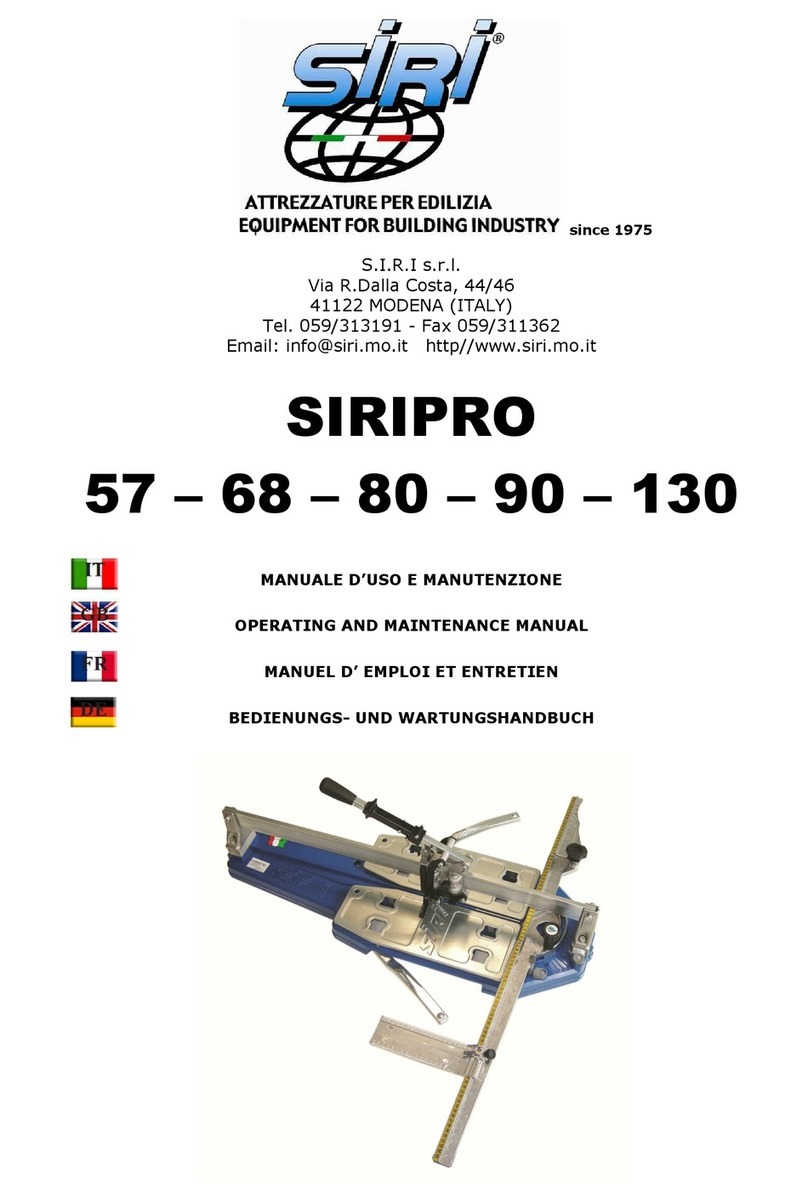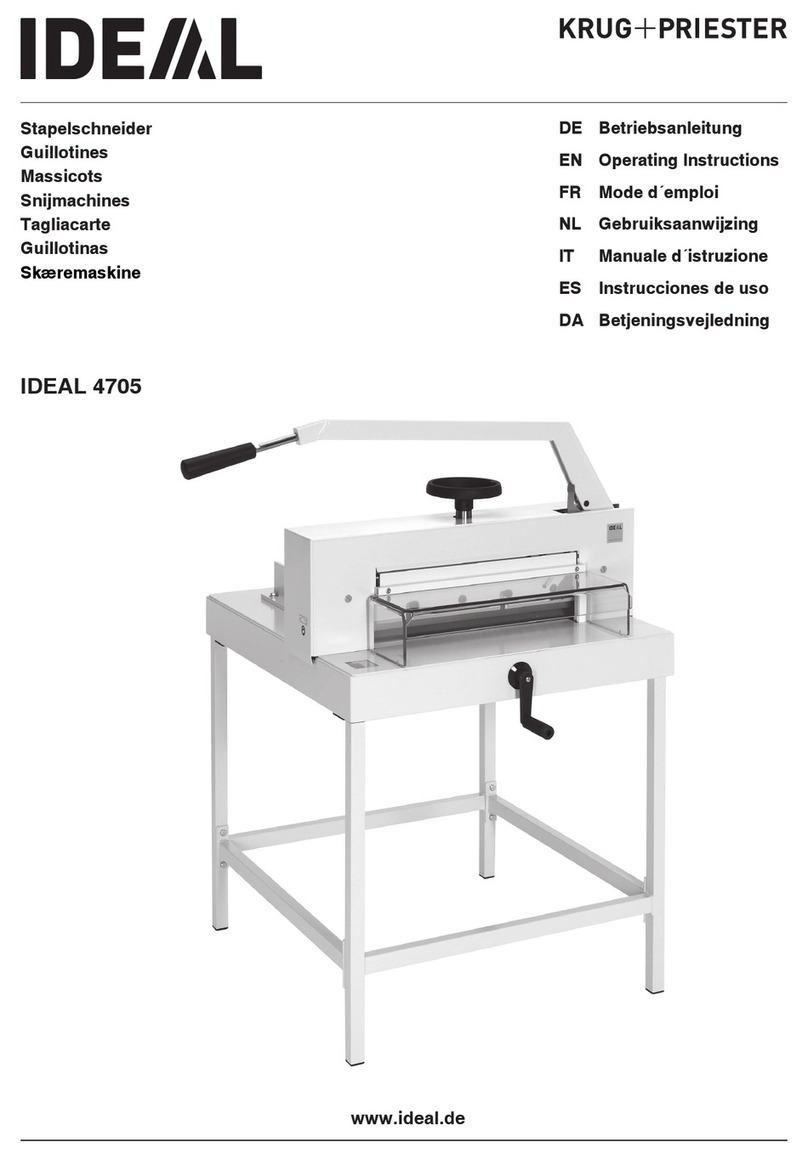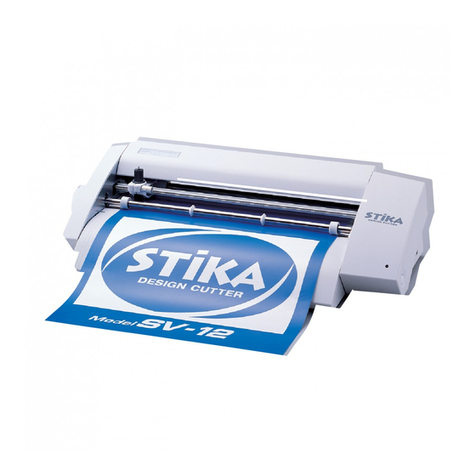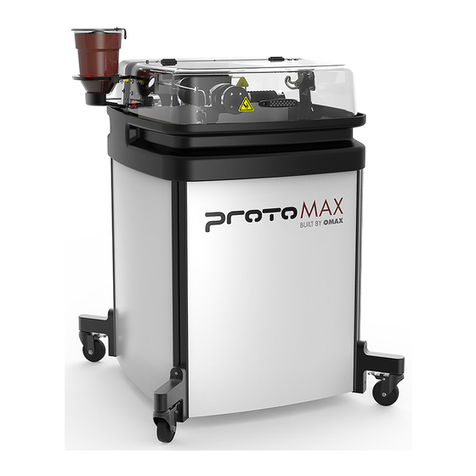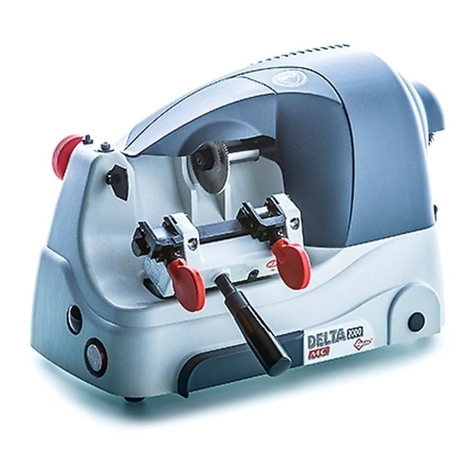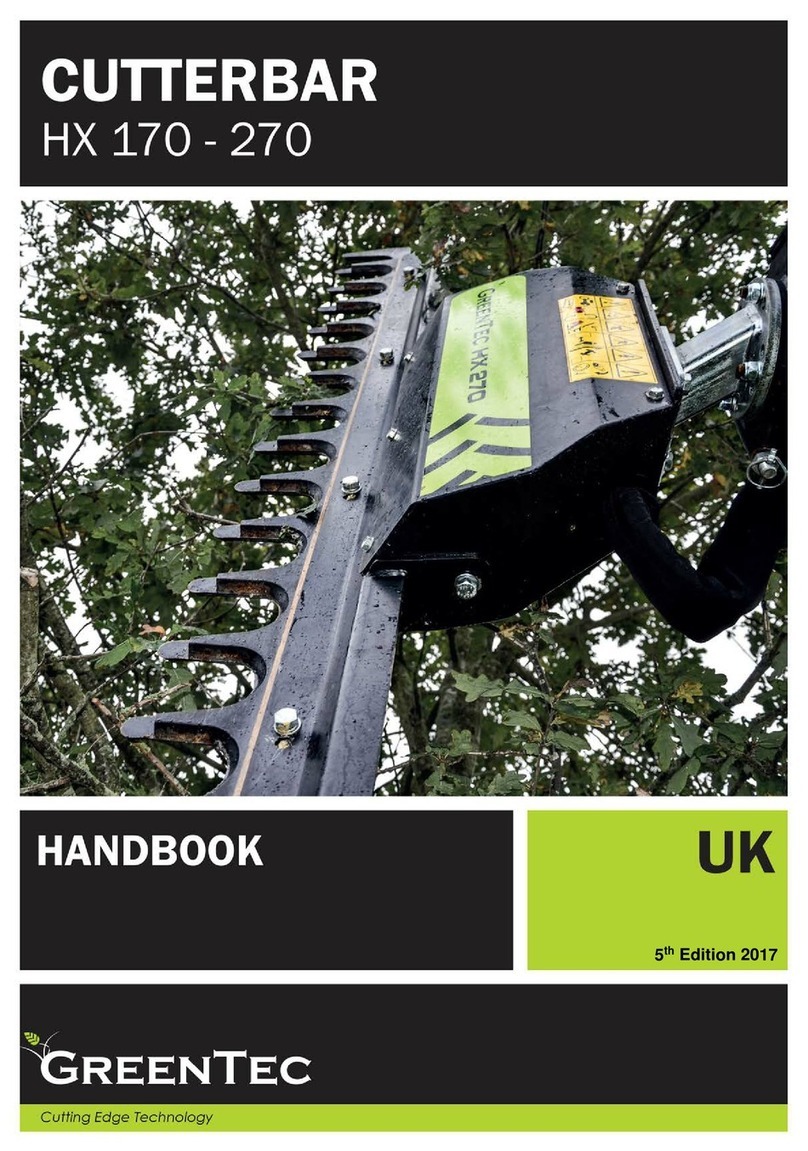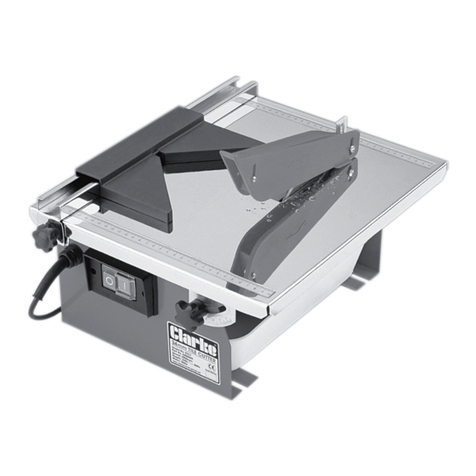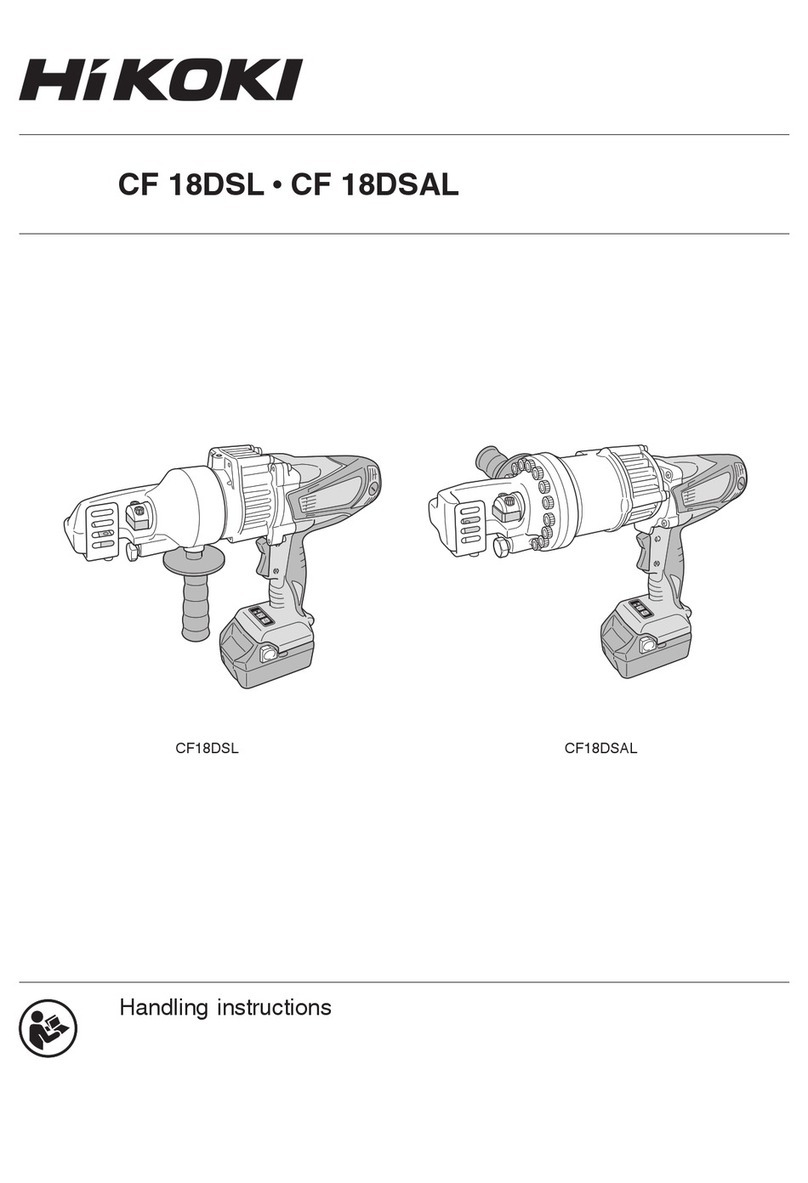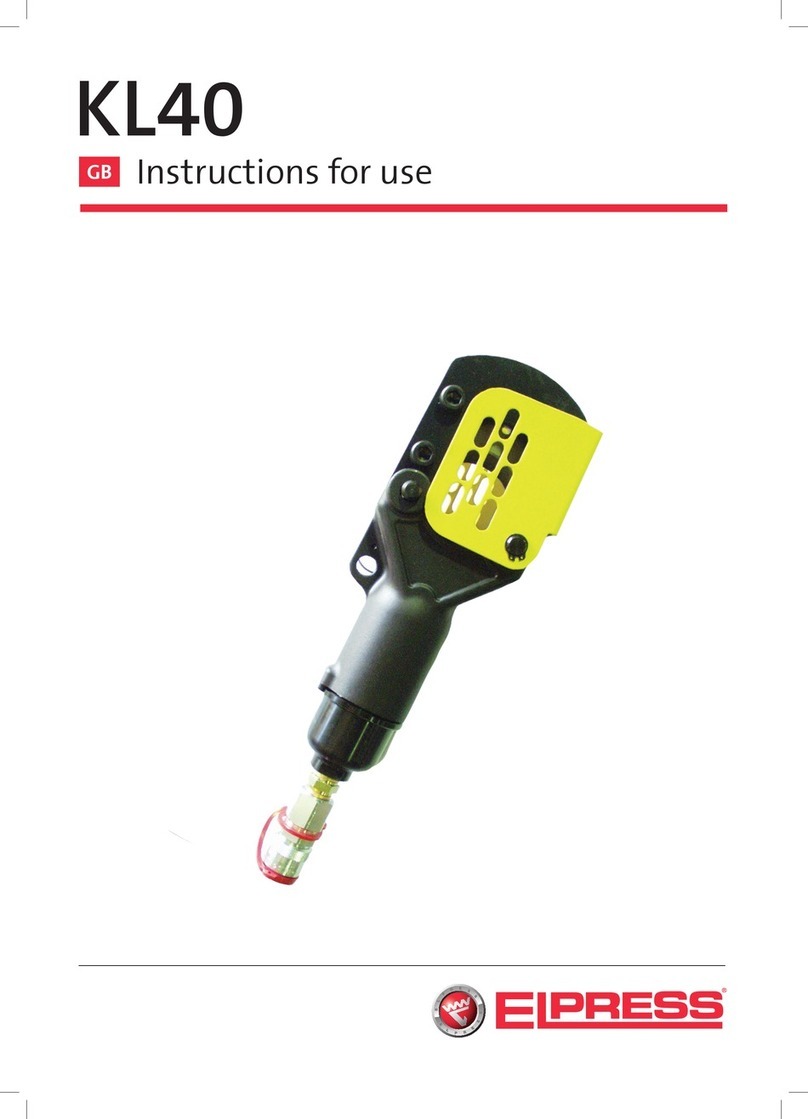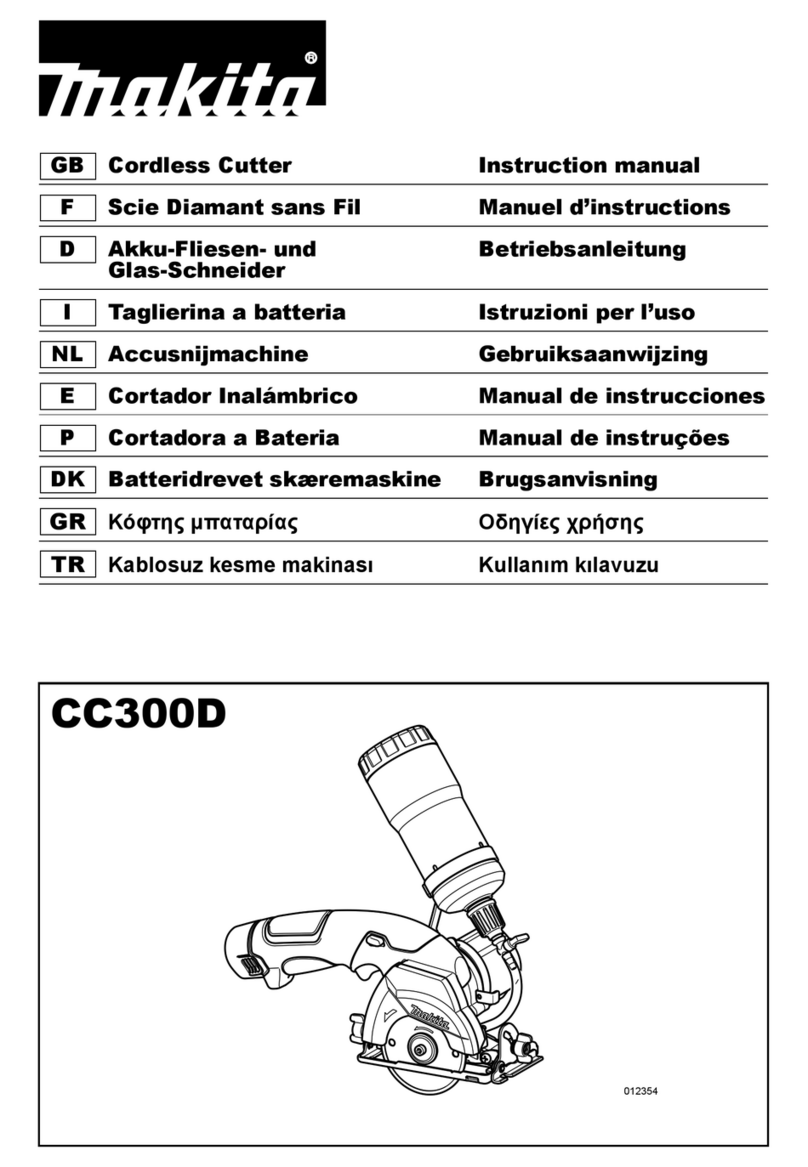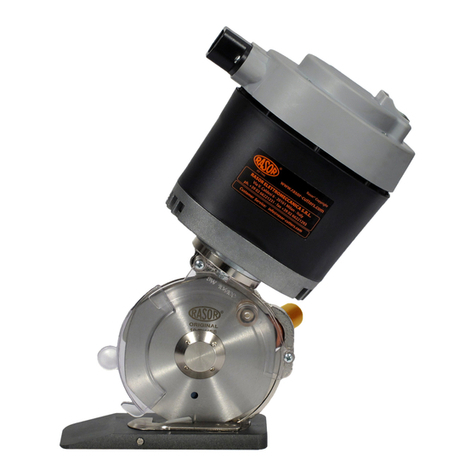Metallkraft RBM-1305-15E User manual

RBM 1305-15 E
Operating Instructions
RBM 1305-15 E
Bending Machine
RBM 1305-15 E

2RBM 1305-15 E | Version 1.02
Imprint
Product identification
Bending Machine Item number
RBM 1305-15 E 3781305
Manufacturer
Stürmer Maschinen GmbH
Dr.-Robert-Pfleger-Str. 26
D-96103 Hallstadt/Bamberg
Fax: 0 951 96555 - 55
E-Mail: [email protected]
Internet: www.metallkraft.de
Indications regarding the operating instructions
Original instructions
Edition: 18.09.2019
Version: 1.02
Language: English
Author: SN
Indications regarding the copyright
Copyright © 2019 Stürmer Maschinen GmbH, Hallstadt,
Germany.
The contents of these operating instructions are the sole
property of the company Stürmer.
Passing on as well as copying of this document, the use
and distribution of its content are prohibited if not explic-
itly permitted. Contraventions are liable to compensa-
tion.
Subject to technical modifications and error.
Content
1 Introduction................................................................................. 3
1.1 Copyright............................................................ 3
1.2 Customer service................................................ 3
1.3 Limitation of liability ............................................ 3
2 Safety........................................................................................... 3
2.1 Symbol explanation ............................................ 3
2.2 Requirements to staff.......................................... 4
2.3 Personal protective equipment........................... 4
2.4 General safety regulations.................................. 5
2.5 Safety lables on the machine ............................. 5
3 Intended use ............................................................................... 5
3.1 Unintended use .................................................. 6
3.2 Residual risks ..................................................... 6
4 Technical Data ............................................................................ 6
4.1 Table................................................................... 6
4.2 Type plate........................................................... 6
5 Transport, packaging, storage.................................................. 7
5.1 Delivery and transport ........................................ 7
5.2 Packaging........................................................... 7
5.3 Storage ............................................................... 7
6 Description of the device........................................................... 8
6.1 Scope of delivery................................................ 8
6.2 Safety switch....................................................... 8
7 Installation and connection ....................................................... 8
7.1 Installation........................................................... 8
7.2 Danger areas...................................................... 9
7.3 Lubrication of the bearing .................................. 9
7.4 Electrical connection .......................................... 9
8 Operation .................................................................................. 10
8.1 Work process.................................................... 11
8.2 Bending process .............................................. 12
9 Cleaning, maintenance and service/repair............................. 14
9.1 Cleaning and maintenance .............................. 15
9.2 Service/Repair .................................................. 15
10 Troubleshooting ..................................................................... 15
11 Disposal, recycling of used devices..................................... 16
11.1 Decommissioning........................................... 16
11.2 Disposal of lubricants..................................... 16
12 Spare parts.............................................................................. 16
11.1 Ordering spare parts ..................................... 16
11.2 Spare parts drawing....................................... 17
13 Electrical-schematic............................................................... 18
14 EC-Declaration of conformity................................................ 19

Introduction
RBM 1305-15 E | Version 1.02 3
1Introduction
You have made a good choice by purchasing the
METALLKRAFT bending machine.
Read the operating manual thoroughly before commissioning
the machine.
It gives you information about the proper commission-
ing, intended use and safe and efficient operation and
maintenance of your bending machine.
The operating manual is part of the Bending Machine
package. Always keep this operating manual in the lo-
cation where your Bending Machine is being operated.
All local accident prevention regulations and general
safety instructions for the operating range of your Bend-
ing Machine must also be complied with.
Illustrations in this operating manual serve the general
understanding and may deviate from the actual design.
1.1 Copyright
The contents of these instructions are copyright. They
may be used in conjunction with the operation of the
bending machine. Any application beyond those de-
scribed is not permitted without the written approval of
Stürmer GmbH.
For the protection of our products, we shall register
trademark, patent and design rights, as this is possible
in individual cases. We strongly oppose any infringe-
ment of our intellectual property.
1.2 Customer service
Please contact your dealer if you have questions con-
cerning your bending machine or if you need technical
advice. They will help you with specialist information
and expert advice.
Germany:
Stürmer Maschinen GmbH
Dr.-Robert-Pfleger-Str. 26
D-96103 Hallstadt
Repair service:
Fax: 0 951 96555-111
E-Mail: service@stuermer-maschinen.de
Spare part orders:
Fax: 0 951 96555-119
E-Mail: ersatzteile@stuermer-maschinen.de
We are always interested in valuable experience and
knowledge gained from using the application-which
then could be shared and be valuable to develop our
products even further.
1.3 Limitation of liability
All information and notes in these operating instructions
were summarised while taking applicable standards
and rules, the state-of-the-art technology and our long-
term knowledge and experiences into consideration.
In the following cases the manufacturer is not liable for
damages:
- Non-observance of the operating instructions,
- Inappropriate use
- Use of untrained staff,
- unauthorized modifications
- technical changes,
- Use of not allowed spare parts.
The actual scope of delivery may deviate from the ex-
planations and presentations described here in case of
special models, when using additional ordering options
or due to latest technical modifications.
The obligations agreed in the delivery contract, the gen-
eral terms and conditions as well as the delivery condi-
tions of the manufacturer and the legal regulations at the
time of the conclusion of the contract are applicable.
2 Safety
This section provides an overview of all important safety
packages for the protection of operating personnel as
well as for safe and fault-free operation. Other task-
based safety notes are included in the paragraphs of
the individual phases of life.
2.1 Symbol explanation
Safety instructions
The safety notes in these operating instructions are
high-lighted by symbols. The safety notes are intro-
duced by signal words which express the concern of
the risk.
DANGER!
This combination of symbol and signal words indi-
cates an imminently dangerous situation which may
lead to death or severe injury if not avoided.
WARNING!
This combination of symbol and signal words indi-
cates a potentially dangerous situation which may
lead to death or severe injury if not avoided.

4RBM 1305-15 E | Version 1.02
Safety
Tips and recommendations
It is necessary to observe the safety notes written in
these operating instructions in order to reduce the risk of
personal injuries and damages to property.
2.2 Requirements to staff
The different tasks described in this manual represent
different requirements to the qualification of the persons
entrusted with these tasks.
Only persons reliable working procedures can be ex-
pected from, are allowed to perform all works. Persons
the responsiveness of which is affected by e. g. drugs,
alcohol or medication, are not allowed to work with the
machine.
The qualifications of the personnel for the different tasks
are mentioned below:
Operator:
The operator is instructed by the operating company
about the assigned tasks and possible risks in case of
improper behaviour. Any tasks which need to be per-
formed beyond the operation in the standard mode
must only be performed by the operator if it is indicated
in these instructions and if the operating company ex-
pressively commissioned the operator.
Electrically qualified person:
Electrically qualified person is due to their professional
training, knowledge and experience as well as knowl-
edge of the relevant standards and regulations, in a po-
sition to carry out work on the electrical systems and to
independently recognize and avoid possible dangers.
Qualified personnel:
Due to their professional training, knowledge and expe-
rience as well as their knowledge of relevant regulations
the specialist staff is able to perform the assigned tasks
and to recognise and avoid any possible dangers them-
selves.
Manufacturer:
Certain works may only be performed by specialist per-
sonnel of the manufacturer. Other personnel is not au-
thorized to perform these works. Please contact our cus-
tomer service for the execution of all arising work.
2.3 Personal protective equipment
The personal protective equipment serves to protect
persons against impairments of safety and health while
working. The staff member has to wear personal protec-
tive equipment while performing different tasks on and
with the machine which are indicated in the individual
paragraphs of these instructions.
The personal protective equipment is explained in the
following paragraph:
CAUTION!
This combination of symbol and signal words indi-
cates a potentially dangerous situation which may
lead to slight or minor injury if not avoided.
ATTENTION!
This combination of symbol and signal words indi-
cates a possibly dangerous situation which may
lead to property and environmental damages if they
are not avoided.
NOTE!
This combination of symbol and signal words indi-
cates a potentially dangerous situation which may
lead to material or environmental damage if not
avoided.
Tips and recommendations
This symbol highlights useful tips and recommenda-
tions as well as information for an efficient and trou-
ble-free operation.
WARNING!
Danger in case of insufficient qualification
of the staff!
Insufficiently qualified persons cannot estimate the
risks while using the vacuum cleaner and expose
themselves and others to the danger of severe or
lethal injuries.
- Have all works only performed by qualified per-
sons.
- Keep insufficiently qualified persons out of the
working area.
Eye Protection
The Eye protection protect the eyes from flying parts
and liquid splashes.
Protective gloves
The protective gloves serve to protect the hands
against sharp components as well as against fric-
tion, abrasions or deep injuries.

Safety
RBM 1305-15 E | Version 1.02 5
2.4 General safety regulations
Please note the following:
-Use the guards and secure them securely. Never work
without protections and get them working.
-Always keep the machine and its working environment
clean. Ensure adequate lighting.
-The bending machine may not be modified in its design
and may not be used for purposes other than those fore-
seen by the manufacturer.
-Never work under the influence of concentration-distur-
bing illnesses, fatigue, drugs, alcohol or medicines.
- Disconnect power before servicing. If any accessories
or maintenance are performed on the machine, the
power supply to the machine must be disconnected
before carrying out any work.
- Keep children and persons not familiar with the bend-
ing machine away from their work environment.
- Do not pull on the mains lead to pull the plug out of the
socket. Protect the cable from heat, oil and sharp
edges.
- Eliminate disturbances that affect safety immediately.
- Never leave the machine unattended.
- Keep the protective device in proper condition. The
machine must not be operated with removed protec-
tion devices.
- Secure the machine at the ON / OFF switch with a pad-
lock as soon as you leave the work area.
- Protect the round bending machine from moisture.
- Make sure that no parts are damaged before using the
Bending Machine. Damaged parts must be replaced
immediately to avoid danger sources.
- Do not overload the bending machine! You work better
and safer in the specified performance range. Use the
right tool! Make sure the tools are not dull or damaged.
- Only use original spare parts and accessories to avoid
possible risks and risks of accidents.
2.5 Safety lables on the machine
The machine has various warning labels and safety
markings that must be observed and followed. The
safety markings attached to the bending machine must
not be removed. Damaged or missing safety markings
can lead to malfunctions, personal injury and material
damage. They are to be replaced immediately.
If the safety markings are not immediately recognizable
and comprehensible, the round bending machine
should be taken out of operation until new safety mark-
ings have been made.
Fig. 1: Safety labels
Safety boots
Safety boots protect the feet from being crushed,
falling parts and slipping over on slippery ground.
Protective clothes
Protective clothes are made of a tightly fitted fabric
without the protruding parts of low tear strength.
NOTE!
This device should be grounded in accordance with
national electrical rules and local rules. This must be
done by a qualified electrician. The machine must be
earthed to protect the user from electric shock.

6RBM 1305-15 E | Version 1.02
Intended use
3 Intended use
The RBM 1305-15 E round bending machine is used ex-
clusively for the production of round shaped parts such
as pipes, cones, cylinders, etc. The material to be bent
must not exceed the maximum sheet thickness speci-
fied for the machine. The machine may only be operated
by a single person who has been instructed in the use
and maintenance of the machine.
Proper use also includes compliance with all information
in this manual. Any use beyond the intended use or oth-
erwise is considered misuse.
3.1 Unintended use
By observing the intended use, no reasonably foresee-
able misuse is possible, which could lead to dangerous
situations with personal injury.
3.2 Residual risks
Even if all safety instructions are observed, and the ma-
chine is put to its intended use, there are still residual
risks, which are listed below:
-There is a risk of injury to the upper limbs (e.g., hands,
fingers).
-Danger from falling workpieces
-Danger from the ingress of clothing and objects.
-During set-up and set-up work, it may be necessary to
dismantle on-site protective equipment. This creates
various residual risks and potential dangers that every
operator must be aware of.
4 Technical Data
4.1 Table
4.2 Type plate
Fig. 2: Type plate RBM 1305-15 E
WARNING!
Dangers in case of unintended use!
Misuse of the bending machine can lead to dange-
rous situations.
- Only operate the bender in the power range speci-
fied in the technical data.
- Never bypass or override the safety devices.
- Only operate the round bending machine in a tech-
nically perfect condition.
Technical Data RBM 1305-15 E
Length 1650 mm
Width / Depth 1020 mm
Height 1110 mm
Weight 318 kg
Power of the drive engine 0,75 kW
Total power 2,5 A
Supply voltage 400 V
Bending bore min. 110 mm
Rolling speed 4 m/min
Working width max. 1270 mm
Diameter of the upper roller 75 mm
Bending capacity max. steel
400 N/mm²
1,5 mm
Conical bending perfor-
mance max. steel 400 N/mm²
0,8 mm
Bending capacity max. VA-
steel
1,1 mm
Conical bending perfor-
mance max. VA-steel
0,6 mm
Bending capacity max. alu-
minium
1,8 mm
Conical capacity max. Alu-
minium
0,9 mm

Transport, packaging, storage
RBM 1305-15 E | Version 1.02 7
5 Transport, packaging, storage
5.1 Delivery and transport
Delivery
Check the bending machine on delivery for any visible trans-
portation damage. If you notice any damage to the device
please report this immediately to the carrier or dealer.
Transport
Transport with a pallet truck / forklift:
The roll bending machine is delivered on a pallet so that
it can be transported with a forklift or pallet truck.
To avoid accidents, the necessary precautions must be
taken when unloading and transporting the machine.
Transport with a crane:
The machine can be placed in a suitable location with a
crane. The machine must be attached to the crane in
accordance with the regulations.
Fig. 3: Transport with a crane
5.2 Packaging
All used packaging materials and packaging aids are
recyclable and should be taken to a materials recycling
depot to be disposed of.
The delivery packaging is made of cardboard, so
please dispose carefully by having it chopped up and
given to the recycling collection.
The film is made of polyethylene (PE) and the cushioned
parts of polystyrene (PS). Deliver these substances to a
collection point for recyclable materials or to the waste
disposal company which looks after your region.
5.3 Storage
Store the bending machine thoroughly cleaned in a dry,
clean and frost-free environment.
It must not be shut down with chemicals in a room.
If the machine must be stored in a damp room, all elec-
trical components in the control cabinet must be pro-
tected by moisture-absorbing agents.
If the machine is stored for a long time, all bare metal
parts must be greased against rusting.
ATTENTION!
When transporting or lifting the bending machine,
observe that the transport and lifting equipment can
take up the load.
WARNING!
Danger to life!
If the weight of the machine and the permissible lift-
ing capacity of the lifting equipment are not
observed during transport or lifting, the machine
may tip over or fall.
- Observe the weight of the machine and the permis-
sible lifting capacity of the lifting equipment during
transport and lifting operations.
- Check lifting gear and load handler for perfect con-
dition.
NOTE!
The machine may only be loaded and unloaded by
qualified personnel.
ATTENTION!
Before transport, check that the upper roller lock is
in the closed position and that the transport ropes
are tight.
NOTE!
- For transportation, all covers must be attached to
the machine frame.
- The machine must not be rocked during transport
by crane.

8RBM 1305-15 E | Version 1.02
Description of the device
6 Description of the device
Illustrations in this operating manual serve the general under-
standing and may deviate from the actual design.
Fig. 4: Controls
1 Top roller folds out
2 Bottom roller
3 EMERGENCY brackets
4 EMERGENCY STOP button
5 Pedals:
right pedal direction of rotation right,
left pedal direction of rotation left
6 Hand wheel for adjusting the rear roller
7 Clamping lever
9 Locking the top roller
10 Behind roller
11 Drive motor
Control panel with pedals
The control panel is equipped with an EMERGENCY
STOP button, which immediately interrupts all machine
movements when disconnected from the power con-
nection until it is released.
Function of the pedals:
right pedal: Direction of rotation.
left pedal: Direction of rotation.
6.1 Scope of delivery
The scope of delivery of the machine includes:
- Driven Top and bottom roller
- Wire insert groove on the top and rear roller
6.2 Safety switch
For the safety of the operating personnel, the machine is
equipped with a safety switch and EMERGENCY STOP
brackets.
When the EMERGENCY STOP brackets is actuated, the
safety switch is activated as with EMERGENCY STOP,
which stops all machine activities.
7 Installation and connection
7.1 Installation
To achieve good functionality and long life of the Bend-
ing Machine, the site should meet the following criteria:
- The substrate must be level, firm and vibration-
free.
- The installation or work area must be dry and well
ventilated.
- Do not operate machines that cause dust and
chips near by.
- There must be sufficient space for the operating
personnel, for material transport as well as for ad-
justment and maintenance work.
- The site must have good lighting.
1
2
4
3
4
5
6
9
10
11
7
Wear safety gloves!
Wear safety shoes!
Wear protective clothing!
CAUTION!
Risk of crushing!
The bending machine can tilt when setting up and
cause serious injuries.
- The round bending machine must be set up by at
least 2 people together.

Installation and connection
RBM 1305-15 E | Version 1.02 9
Setting up the machine
Step 1: Check the surface for horizontal alignment, if
necessary, compensate for slight unevenness.
Step 2: Fix the round bending machine with ground an-
chors to the ground and align horizontally with a
spirit level.
7.2 Danger areas
The bending machine is provided with the necessary
protective equipment to prevent injuries that may be
caused by the worm gear or other gears. Another area
of danger that must be carefully observed during the
machining process is the range of rotation of the rollers.
7.3 Lubrication of the bearing
Before using the machine for the first time, check and lu-
bricate the bearings and gears, see chapter „Cleaning
and maintenance“.
7.4 Electrical connection
It is important to make sure that,
- the power connection has the same characteris-
tics (voltage, mains frequency, phase angle) as
the motor.
- the mains voltage of 400 V is used,
- For the purpose of a safe working operation the
earthing is checked.
Step 1: Connect the power cord to the mains.
Step 2: Insert the pedal plug on the machine.
Step 3: Check that the direction of rotation of the rollers
and the motor corresponds to the indicated di-
rection of the arrow. In some cases, a reverse
connection may cause the motor to burn out. It
must also be checked whether the direction of
rotation of the roller is carried out in accordance
with the operation of the respective buttons on
the control panel or according to the operation of
the respective pedal:
right pedal: Rotation direction right;
left pedal: Rotation direction left.
Step 4:
If the direction of rotation is reversed, the cables
must be reconnected by a qualified electrician.
NOTE!
- The Bending Machine is already pre-assembled in
the delivery condition.
NOTE!
After setting up, remove the protective agent from
the bare metal parts, which have been applied to
protect against rusting.
- Use usual solvents.
- No water, no nitrolic solvents or similar use!
NOTE!
The moving parts must be free from dirt and dust.
- If necessary, lubricate the moving parts as listed in
the Care and Maintenance section.
DANGER!
Danger to life due to electric current!
There is an immediate danger of electrocution on
contact with live components.
- The bending machine may only be connected by
electricians.
- Work on the electrical system should only be carried out by
qualified electricians.
ATTENTION!
After connecting the plug, check the direction of
rotation of the motor. If this is wrong, two phases
must be exchanged.

10 RBM 1305-15 E | Version 1.02
Operation
Power box
The power box contains the controls of the machine and
is connected to the pedal.
Fig. 5: Power box
Check direction of rotation
Step 1:Turn on the main switch.
Step 2:Press the START-button.
Step 3:Press the pedals and check the direction of rota-
tion of the rollers. If necessary, the connections
must be reconnected by an electrician to obtain
the correct direction of rotation.
Step 4: Switch off the machine with the EMERGENCY
STOP button on the mobile control panel.
Step 5: Turn off the main switch.
8Operation
WARNING!
The main power supply should be protected by cir-
cuit breakers against possible overvoltages!
ATTENTION!
The electrical box may only be opened for mainte-
nance and adjustment work!
WARNING!
Danger due to insufficient qualification of persons!
Insufficiently qualified persons can not assess the
risks involved in handling the bending machine and
expose themselves and others to the risk of serious
or fatal injuries.
- All work should only be carried out by qualified per-
sons.
- Keep inadequately qualified persons out of the
work area.
WARNING!
Risk of crushing!
The upper limbs must be kept away from the
machine during feed and during machining of the
workpiece.
ATTENTION!
- Never perform any work on the bending machine
under the influence of alcohol, drugs or medication
and / or in case of fatigue or concentration distract-
ing illnesses.
- The bending machine may only be operated by a
trained person.
ATTENTION!
Before using the round bending machine for the first time, it
is essential to lubricate the chains and bearings!
We assume no liability for damages due to improper
commissioning.
ATTENTION!
When operating the rollers: Do not drive the rollers against
the lower stop!
ATTENTION!
- The operator should have a basic knowledge of
this type of machine.
- Operators should not wear wide garments, neck-
laces, rings, etc. to prevent them from being pulled
into the running machine.
- If faults occur, the EMERGENCY STOP button must
be pressed immediately.

Operation
RBM 1305-15 E | Version 1.02 11
The machine is designed for steel processing and not
for processing flammable or harmful substances. The
customer is responsible for the choice of the material to
be processed.
It must also be ensured that the safety of nearby operat-
ing personnel is ensured.
The material should meet the following requirements:
- Dry and clean, free of oil.
- The diameter must correspond to the specifica-
tions.
- The material should have a degree of hardness
throughout.
- Buying high quality material is advisable.
- The surface of the areas to be bent should be
smooth.
The RBM 1305-15 E round bending machine has three
rollers driven by an electric motor and a gearbox. There-
fore, the bending process is simple and smooth; how-
ever, some experience is needed to work efficiently.
A complete bend with one pass is not possible. To get
the desired radius, several passes are required. Tighter
bends and full radii always require several passes.
In order to be able to remove a bent workpiece from the
machine, the right-hand lock of the upper roller must be
released and the upper roller must be removed from the
guide.
Fig. 6: Lock of the top roller
8.1 Work process
Step 1: Before starting the machine, the lock of the top
roller must be checked.
Step 2: Check the parallelism of the rollers with a gauge
and spirit level.
Fig. 7: Checking parallelism of rollers
Step 3: Clean the rollers and the workpiece.
Step 4: Turn on the main switch. The operating display
lights up.
Step 5: Press the START button.
Step 6: Press the pedals to activate the rollers.
Step 7: Perform bending operation.
Step 8: Stop the rollers after completing the bending
process. Move roller down.
Step 9: Release the upper roller lock, fold out the upper
roller and remove the workpiece. Use a crane to
support the workpiece.
NOTE!
To be observed before commissioning:
- The mains voltage must correspond to the voltage
specifications on the rating plate.
- The safety devices as well as the protective covers
must be functional.
NOTE!
It is important to thoroughly clean the rollers to avoid
possible slippage of the profile due to grease resi-
dues on the rollers.
Wear protective gloves!
Wear safety boots!
Wear protective clothes!
Lock

12 RBM 1305-15 E | Version 1.02
Operation
Step 10: Fold in the top roller and lock.
Step 11: Switch off the machine with the main switch.
8.2 Bending process
Bending may only be performed by qualified personnel
experienced in these machines. All steps of bending,
pre-bending and conical bending must be carried out
extremely carefully. It should be noted that a small ra-
dius is made by repeating the bending process several
times; Once too much bent, this step can not be un-
done.
Before processing
- Remove dirt and oil from the material.
- The material ends must be free of chips and burnt
residues.
- Burned material is harder at the points of separa-
tion than in the remaining area.
- The material has to be level.
- It is recommended to make a stencil made of card-
board or cardboard for the desired radius.
Always work the workpiece in the center of the rollers.
Fig. 8: Position the workpiece in the middle of the rollers
Calculation of the workpiece length
Fig. 9: Calculation of the workpiece length
Bending chart
Fig. 10: Bending chart
Pre bending
Pre-bending is the operation whereby the ends of the
material are bent to the same radius as the final radius.
As a result, the best results are achieved at full radii (eg
making tubes) or for operations where no flat ends are
desired.
Bending
ATTENTION!
The unfolded top roller must not be overloaded by
the workpiece. The workpiece must be supported by
a crane.
WARNING!
Do not use profiles that go beyond the strength
specification. Do not work on more than one piece at
a time. Use the machine only for the intended pur-
pose.
NOTE!
The material hardens a little bit more after each
pass.
When processing stainless steel, several passes
must be made because this material is work harden-
ing material.

Operation
RBM 1305-15 E | Version 1.02 13
Fig. 11: Bending process
Conical bending
Conical bending is more difficult than normal bending.
The machine performance is reduced by 30% to 50%,
the conical bending capacity decreases by about 25%.
The material thickness must be reduced accordingly.
Fig. 12: Bending capacity chart
Calculation of the dimension of the workpiece
Fig. 13: Calculation of the dimension of the workpiece
Adjusting of the material thickness
Step 1: Loosen the knurled screw to the right of the ad-
justing screws.
Step 2:Turn the adjusting screws to raise or lower the
lower clamping roller.
Step 3:Insert the material between the rollers from the
front of the machine and set the rollers so that the
material is tight. Tighten the thumbscrews and
remove the material between the rollers.
Front adjusting screw and rear hand wheel
The 2 adjusting screws are installed in the left and right
side frames.
This allows the operator to raise or lower the pinch roller
so that the correct gap between the upper and lower
pinch rollers can be obtained to insert the desired mate-
rial into the machine.
The rear handwheel assist the operator in raising or low-
ering the guide roll, which determines the degree of
bending in the material being fed through the machine.
The hand wheel is equipped with a scale that helps the
operator to adjust.
Bending process
Step 1: After adjusting the diameter, insert the material
on the front of the roller and turn the control han-
dle clockwise until about half of the material has
passed through the rollers.
Step 2: When the roller is driven, make sure that the up-
per roller rotates counterclockwise. While the
material is being fed, lift the idler and continue
rotating until a semicircle is formed.
Top and bottom roll in
straight position
For finishing pre-banding
bring the rear roll upwards
Roll until the desired di-
ameter is achieved
Last pass
Yield strength
(material thickness)
Ratio of conical
bending capacity
t = bending capacity
The conical bending takes
place problem-free
material with a yield strength of 470 N/mm² until a diameter
660 mm with a thickness of 2 mm
material with a yield strength of 235 N/mm² until a diameter
660 mm with a thickness of 3 mm
material with a yield strength of 175 N/mm² until a diameter
660 mm with a thickness of 4 mm
Roll diameter: 220 mm
Pre bending capacity: 4 mm
Bending capacity: 6 mm
Example for
Conical bending in dependence of bending capacity
Notice: The values have been enlarged with the factor 3 in according of the roll diameter
For finishing pre-banding
bring the rear roll upwards
Turn sheet metal and posi-
tion it for the second pre-
bending

14 RBM 1305-15 E | Version 1.02
Cleaning, maintenance and service/repair
.
Step 3:
After the formed semicircle, reinsert the un-
shaped material into the roller and turn the actua-
tion handle clockwise to form a complete circle.
Withdrawal of the workpiece
Step 1: After completing the bending process, support
the workpiece with a crane.
Step 2: Move the lower and rear roller down.
Step 3: Release the lock on the top roller.
Step 4: Swing top roller out.
Fig. 14: Swing out of the tp roller
Step 5: Remove workpiece. Use a crane to support the
workpiece.
Step 6: Swing the top roller back into the bearing and
lock it.
Fig. 15: Workpiece withdrawal with lifting device
9 Cleaning, maintenance and service/
repair
NOTE!
It is important that the roller rotates while you oper-
ate the cam lever. When the cam lever is engaged
while the rollers are not rotating, a noticeable flat
spot or line is formed across the width of the mate-
rial.
ATTENTION!
When the upper roller is tilted, the upper roller must
not be overloaded by the workpiece. The workpiece
must be supported by a crane.
Tips and recommendations
To ensure that the bending machine is always in
good operating condition, regular care and mainte-
nance work must be carried out.
DANGER!
Danger due to insufficient qualification of
persons!
Insufficiently qualified personnel can not assess the
risks involved in maintenance work on the machine
and expose themselves and others to the risk of seri-
ous injury.
- All maintenance work should only be carried out by
qualified persons.
DANGER!
Danger to life due to electrical shock!
There is a danger to life when in contact with live
components.
- Always unplug the appliance before cleaning and
maintenance.
- Connections and repairs of the electrical equip-
ment may only be carried out by a qualified electri-
cian.
NOTE!
Before servicing and maintaining the bending
machine, the maintenance instructions must be read
carefully. Handling the Bending Machine is only per-
mitted to persons who are familiar with the Bending
Machine.
ATTENTION!
After servicing, maintenance and repair work, check
that all panels and guards are properly installed on
the machine again and that there is no more tools
inside or in the working area of the round bending
machine.
Damaged safety devices and parts must be repaired
or replaced by the customer service.

Troubleshooting
RBM 1305-15 E | Version 1.02 15
9.1 Cleaning and maintenance
Regularly clean the bending machine with a soft, damp
cloth.
Treat bare metallic work surfaces with anti-rust spray.
Clean the rollers regularly.
Maintenance (lubrication)
The points listed in the table must be lubricated regu-
larly at least once a month or more often for a period of
more than eight hours daily.
Some of these locations are inside the machine and can
only be accessed after removing the cover.
- The gearbox under the front cover is maintenance-
free and only needs to be checked from time to
time.
- The engine and frame mounting screws are tight-
ened if necessary.
9.2 Service/Repair
If the bender does not work properly, contact a dealer or
our customer service. The contact details can be found
in chapter 1.2 Customer Service.
10 Troubleshooting
ATTENTION!
- Never use solvents to clean plastic parts or painted
surfaces. A surface release and consequential
damage may occur.
ATTENTION!
The rollers must not be lubricated or oiled. You would
allow slipping of the material and thus trigger no
bending process. The rollers are always free from
grease and oil.
Nr Interval lubricants
1 bearing, mov-
able parts
monthly oil
2 gears half-yearly grease
ATTENTION!
Repair work may only be carried out by qualified
personnel.
All protection and safety equipment must be rein-
stalled immediately after completion of repair and
maintenance work.
ATTENTION!
If one of the following errors occurs, stop working
with the machine immediately. It could lead to seri-
ous injuries. All repairs or replacement work may
only be carried out by qualified and trained special-
ist personnel.
Trouble Possible cause Remedy
The bending machine does not
work.
1. The mechanics are broken. 1. Check the mechanics.
2. Contact the dealer.
The bending machine does not start
working.
1. Connection cable loose.
2. Engine defective.
1. Verbindungskabel lose
2. Contact a specialist dealer.
The bending machine does not
bend the material correctly.
1. The material thickness could be
wrong.
2. The wrong material has been in-
serted.
1. Observe max. sheet thickness.
2. Only insert the right material.
The bending machine does not
bend the materials as indicated in
the catalog.
1. The material thickness could be
wrong.
2. The mechanics are faulty.
1. Check the material to be bent.
2. Contact the dealer.

16 RBM 1305-15 E | Version 1.02
Disposal, recycling of used devices
11 Disposal, recycling of used devices
Please take care in your own interest and in the interest
of the environment that all component parts of the ma-
chine are only disposed of in the intended and permit-
ted way.
11.1 Decommissioning
Immediately decommission disused machines in order
to avoid later misuse and endangering of the environ-
ment or personal safety.
- Eliminate all environmentally hazardous operating ma-
terials from the used device.
- If required, disassemble the machine into easy-to-han-
dle and usable components and parts.
- Dispose of machine components and operating mate-
rials by the disposal channels provided.
11.2 Disposal of lubricants
Remove any leaking, used or excessive grease at the lu-
bricating points.
Disposal notes for used lubricants are available from the
manufacturer of the lubricants. If necessary, request the
product-specific data sheets. The disposal instructions
for the lubricants used are provided by the lubricant
manufacturer. If necessary, ask for the product-specific
data sheets.
12 Spare parts
12.1 Ordering spare parts
The spare parts may be purchased with the authorized
dealer or directly with the manufacturer. Please find the
corresponding contact data in Chapter 1.2 Customer
service.
Indicate the following basic information for requests or
orders of spare parts:
- Type of device
- Item No.
- Position No
- Year of construction:
- Quantity
- Required mode of dispatch (mail, freight, sea, air,
express)
- Address of dispatch
Spare part orders which do not include the above indi-
cations may not be taken into consideration. If the indi-
cations regarding the mode of dispatch are missing, the
product is dispatched at the discretion of the supplier.
You will find information regarding the device type, item
No. and year of manufacture on the type plate fixed to
the bending Machine.
Example
The motor for the bending machine RBM 1305-15 E
must be ordered. This is indicated in the spare parts
drawing with the item number 111.
When ordering spare parts, send a copy of the spare
parts drawing with the marked component ( motor ) and
marked position number (111) to the authorised dealer
or to the spare parts department and provide the follow-
ing information:
- Device type: Bending Machine
- Item number: 3781305
-Position number: 111
The item number of your device:
Bending machine RBM 1305-15E : 3781305
DANGER!
Danger of injury by the use of
wrong spare parts!
Dangers may result for the user and damages as
well as malfunctions may be caused by using wrong
or damaged spare parts.
- Only use original spare parts of the manufacturer or
spare parts admitted by the manufacturer.
- Always contact the manufacturer in case of uncer-
tainties.
NOTE!
Using non-approved spare parts voids the manufac-
turer's warranty.

Spare parts
RBM 1305-15 E | Version 1.02 17
12.2 Spare parts drawing
In case of service, the following drawing shall help to identify the necessary spare parts. If necessary, send a copy of
the parts drawing with the marked components to your authorized dealer.
Fig. 16: Spare parts drawing RBM 1305-15 E

18 RBM 1305-15 E | Version 1.02
Electrical-schematic
13 Electrical-schematic
Fig. 17: Electrical-schematic RBM 1305-15 E

EC-Declaration of conformity
RBM 1305-15 E | Version 1.02 19
According to machine directive 2006/42/EC Annex II 1.A
Manufacturer/retailer: Stürmer Maschinen GmbH
Dr.-Robert-Pfleger-Starße 26
D-96103 Hallstadt
herewith declares that the following product
Product group: Metallkraft®Metallbearbeitungsmaschinen
Designation of machine: RBM 1305-15 E
Machine type: Bending Machine
Item number: 3781305
Serial number: ____________________
Year of manufacture: 20____
corresponds, on the basis of its design and construction, as well as the version that we have put into circulation, with the
relevant fundamental health and safety requirements of (subsequent) EC guidelines.
The following harmonized standards were applied:
DIN EN ISO 12100:2011-03
DIN EN 60204-1:2014-10
Responsible for documentation:
Safety of machinery - General principles for design -Risk assessment and risk re-
duction
Safety of machinery - Electrical equipment of machines - Part 1: General require
ments
Kilian Stürmer, Stürmer Maschinen GmbH,
Dr.-Robert-Pfleger-Str. 26, D-96103 Hallstadt
Hallstadt, 12.09.2018
______________________
Kilian Stürmer
Directors
14 EC-Declaration of conformity

www.metallkraft.de
This manual suits for next models
1
Table of contents
Other Metallkraft Cutter manuals


